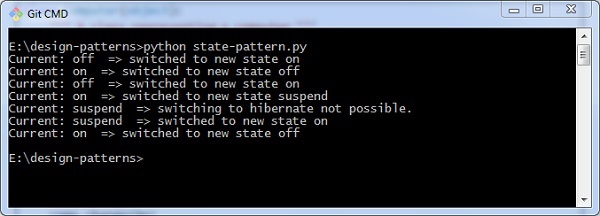
- Python 設計模式教程
- Python 設計模式 - 主頁
- 簡介
- Python 設計模式 - 概要
- 模型檢視控制器模式
- Python 設計模式 - 單例
- Python 設計模式 - 工廠
- Python 設計模式 - 建造者
- Python 設計模式 - 原型
- Python 設計模式 - 外觀
- Python 設計模式 - 命令
- Python 設計模式 - 介面卡
- Python 設計模式 - 裝飾器
- Python 設計模式 - 代理
- 責任鏈模式
- Python 設計模式 - 觀察者
- Python 設計模式 - 狀態
- Python 設計模式 - 策略
- Python 設計模式 - 模板
- Python 設計模式 - 享元
- 抽象工廠
- 面向物件
- 面向物件概念實現
- Python 設計模式 - 迭代器
- 字典
- 列表資料結構
- Python 設計模式 - 集合
- Python 設計模式 - 佇列
- 字串和序列化
- Python 中的併發
- Python 設計模式 - 反
- 異常處理
- Python 設計模式資源
- 快速指南
- Python 設計模式 - 資源
- 討論
Python 設計模式 - 狀態
它提供了一個用於狀態機的模組,這些狀態機使用子類實現,這些子類派生自指定的狀態機類。這些方法與狀態無關,並會觸發使用裝飾器宣告的轉換。
如何實現狀態模式?
狀態模式的基本實現如下所示 −
class ComputerState(object):
name = "state"
allowed = []
def switch(self, state):
""" Switch to new state """
if state.name in self.allowed:
print 'Current:',self,' => switched to new state',state.name
self.__class__ = state
else:
print 'Current:',self,' => switching to',state.name,'not possible.'
def __str__(self):
return self.name
class Off(ComputerState):
name = "off"
allowed = ['on']
class On(ComputerState):
""" State of being powered on and working """
name = "on"
allowed = ['off','suspend','hibernate']
class Suspend(ComputerState):
""" State of being in suspended mode after switched on """
name = "suspend"
allowed = ['on']
class Hibernate(ComputerState):
""" State of being in hibernation after powered on """
name = "hibernate"
allowed = ['on']
class Computer(object):
""" A class representing a computer """
def __init__(self, model='HP'):
self.model = model
# State of the computer - default is off.
self.state = Off()
def change(self, state):
""" Change state """
self.state.switch(state)
if __name__ == "__main__":
comp = Computer()
comp.change(On)
comp.change(Off)
comp.change(On)
comp.change(Suspend)
comp.change(Hibernate)
comp.change(On)
comp.change(Off)
輸出
上述程式生成以下輸出 −

廣告